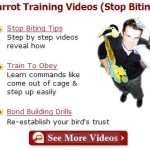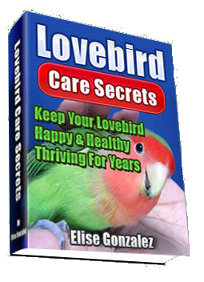Lovebirds for Sale – Training a Lovebird for Lovebird Breeding
|
People looking for lovebirds for sale often want to find hand raised baby lovebirds that won’t bite them. If you want to get into lovebird breeding so you can make some money and help people find hand raised peach faced lovebirds or the other varieties, there are some steps you need to take first. Know When to Pull the Babies From Mom and Dad The tamest babies are generally taken from the parents between 10-14 days; you can pull the whole clutch when the youngest baby is between 9-10 days old. Try to avoid anything past 17 days, it gets harder to hand-raise them the older they become. Allow the lovebirds to keep warm by cuddling with each other in a brooder; you can make one using a plastic container covered with a lid with slits for air. Inside put a few inches of CareFresh Cage Liner and cover with untreated paper towels that you can replace each time you clean. It is very important that you change the paper towels regularly as baby lovebirds are very susceptible to bacterial infections. Use a fairly large container so that you can separate it into two sections; one side for cuddling and one for eating. Get Properly Trained Before Feeding If you can get someone who is properly trained at hand-feeding, you will be more confident that you know what you are doing; you do NOT want to starve the baby birds. Hand feeding isn’t an exact science, every bird is different and you must be sure that you aren’t getting any formula into the bird’s lungs. Four to five feedings a day is typical at first, Exact Hand-Feeding formula is excellent brand to use. Make sure the formula is between 103-105 degrees Fahrenheit, but some birds like the temperature colder, some hotter you have to see what your bird seems to prefer. You can kill a bird if the temperature is TOO hot so be sure to check it with a quality digital thermometer before feeding. If you use a microwave to heat your formula, stir it well to get rid of any hot spots and be sure to test the temperature again. When to Introduce Other Foods The earlier the better in most cases, around 21 days works best. You can give them millet, sunflower sprouts and crumbled Roudybush pellets. Change the type of food you give every day to avoid food phobias. If a lovebird is not exposed to enough foods, it is pretty common for them to avoid real food later in life. Around 5 or 6 weeks of age your lovebird may be ready to give up the syringe. You have successfully weaned your bird when it no longer cries for food and seems to be eating normally; it is always better to hand-feed too long than not long enough. When to Sell the Lovebird Wait 3 or 4 more days before you sell your lovebird to be sure that they are officially weaned. A bird’s appearance or vitality will change quickly if they were not quite ready to quit formula; this can also help prevent regression, when a bird is weaned too quickly, becomes insecure and is looking for mom. Try spoon feeding the bird the last few days of hand-feeding. This is something you can show the new owner in case the bird needs it once they have gone to a new home, it is less risky than a new owner trying to use a syringe. Socialize the Bird Aside from ensuring that a baby is properly fed, socializing is the next important step. Handle the lovebird between feedings as frequently as possible, the more times you can reach in and pick up the bird the better. Let the baby cuddle with you each night too, don’t just handle them at feeding time, it is important to hold them as often as you can. Continue to handle the bird even after you have weaned him, they can quickly go wild again if they are not consistently held. To learn more about this or if you have a hand-raised lovebird that ISN’T, CLICK HERE. |






